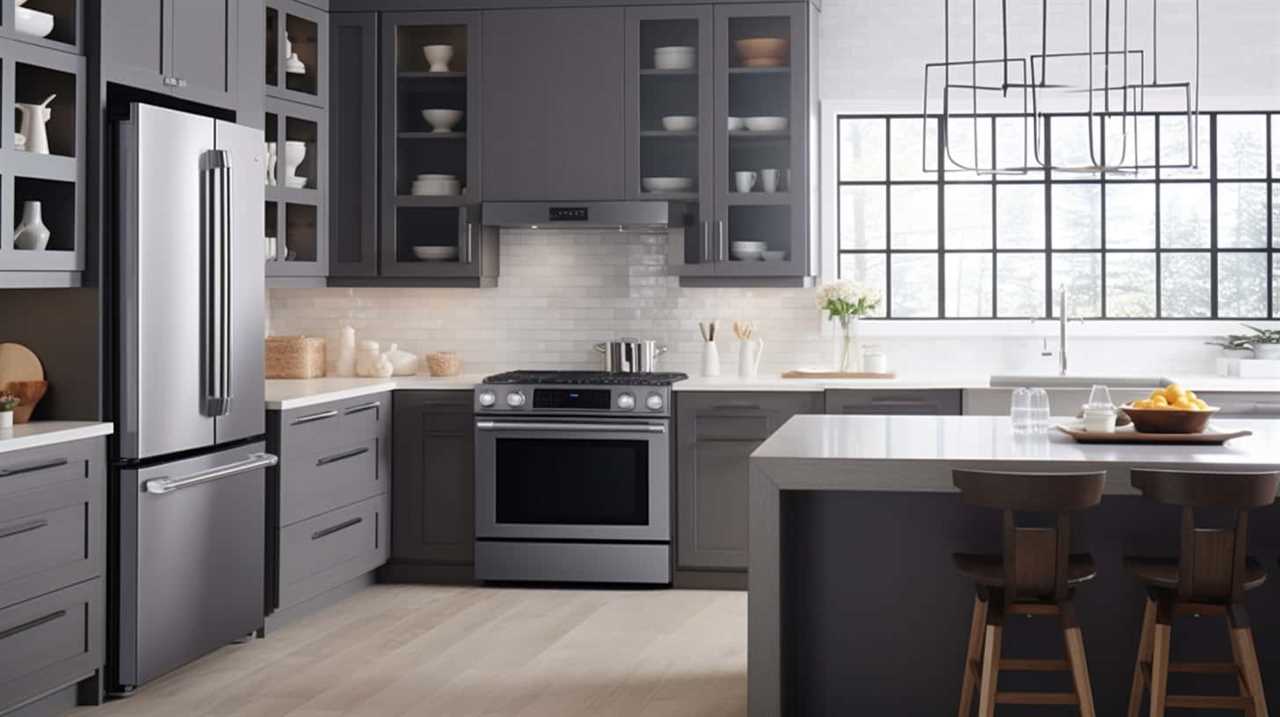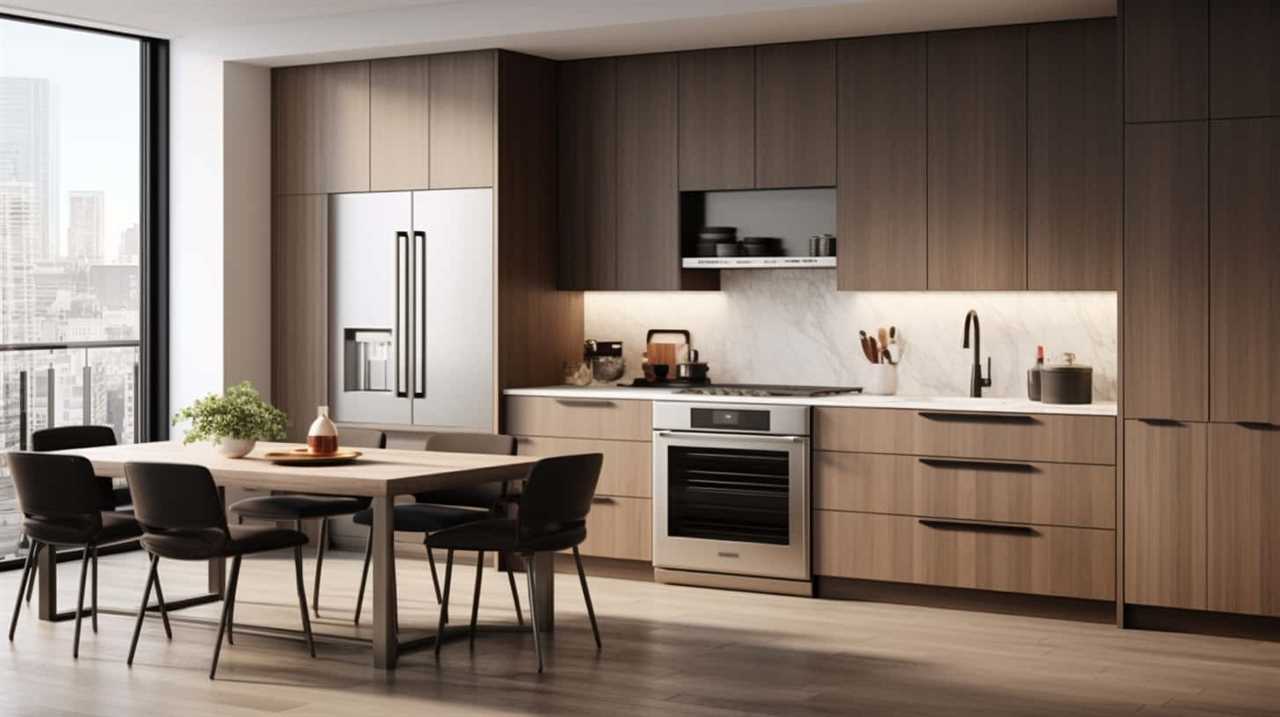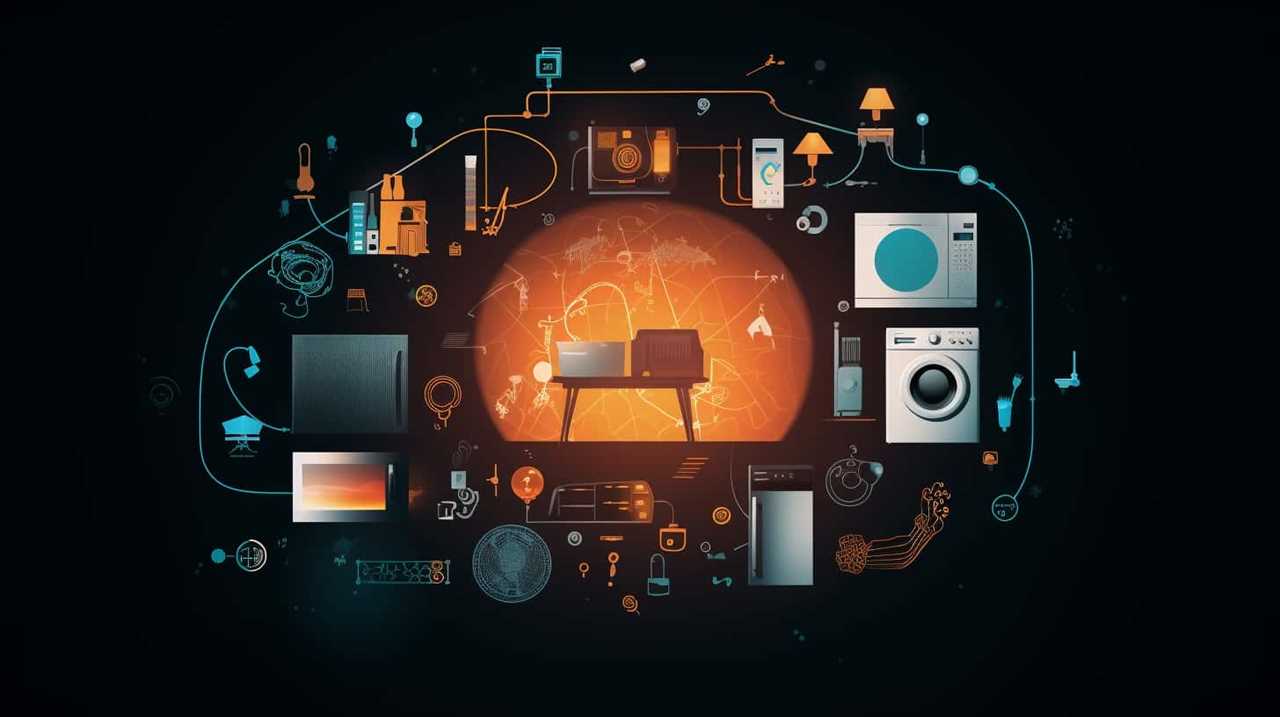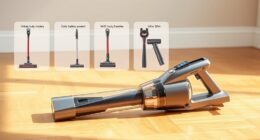Welcome to the realm of appliance operation! Learning how appliances function is crucial for anyone looking to excel in this industry. From refrigerators to dishwashers, ovens to washing machines, each appliance carries out a unique task with the assistance of different parts. By grasping the complex mechanisms behind their operation, you will be able to troubleshoot issues and enhance their efficiency.
In this guide, we will explore the fundamental components that make up appliances, such as the power source, control panel, heating elements, cooling system, filters and ventilation, as well as safety features. Additionally, we will discuss the importance of maintenance, cleaning, and troubleshooting tips to ensure smooth operation.
So, whether you aspire to become an appliance technician or simply desire a deeper understanding of the appliances in your home, let’s delve into the fascinating world of how appliances work.
Key Takeaways
- Appliances can be powered by electricity, gas, or renewable energy, with renewable energy sources having a lower carbon footprint.
- Energy-efficient appliances consume less electricity while delivering the same functionality, reducing electricity bills and contributing to environmental sustainability.
- Control panels in appliances have specific buttons for various functions, and a well-designed user interface enhances usability and satisfaction.
- Regular maintenance, including cleaning, inspection, and proper care, is essential for efficient functioning and longevity of appliances.
Basic Components
Basic Components of an appliance include the essential elements that enable its proper functioning. These components are designed to ensure optimal power consumption and energy efficiency.

The power supply unit is responsible for converting the incoming electrical energy into the appropriate voltage and current required by the appliance.
The control panel, equipped with buttons or a touchscreen display, allows users to interact with the appliance and adjust its settings.
The motor, typically found in appliances like washing machines or refrigerators, converts electrical energy into mechanical energy to perform specific tasks.
Heating elements, such as coils or burners, generate heat for cooking or water heating purposes.

Additionally, sensors and timers are commonly integrated to monitor and regulate various functions of the appliance, contributing to its overall energy efficiency and performance.
Power Source
The power source is a crucial component in the functionality of an appliance. Electricity is the most common power option, providing the necessary energy to operate the device.
However, there are also alternative power options available, such as batteries or solar power, which can be used in certain appliances.
The choice of power source can have a significant impact on the overall performance and efficiency of the appliance.

Electricity and Functionality
One essential aspect of an appliance’s functionality is its reliance on a singular power source, namely electricity. The efficient usage of electricity is crucial for optimizing an appliance’s performance and minimizing energy consumption.
When it comes to electricity usage, appliances can be broadly categorized into two types:
- Energy-efficient appliances: These appliances are designed to consume less electricity while delivering the same level of functionality. They incorporate advanced technologies and innovative features such as energy-saving modes, power management systems, and intelligent sensors. Energy-efficient appliances not only help reduce electricity bills but also contribute to environmental sustainability.
- Non-energy-efficient appliances: These appliances consume more electricity compared to their energy-efficient counterparts. They may lack features like power-saving modes or have outdated technology that leads to higher energy consumption. It is important to consider the energy efficiency ratings of appliances when making purchasing decisions to ensure optimal electricity usage and minimize environmental impact.
Different Power Options
Appliances can be powered by various sources, including electricity, gas, or renewable energy, depending on the specific type and design. The choice of power source can have a significant impact on the functionality and performance of the appliance.
In recent years, there has been a growing interest in solar energy as a power source for appliances. Solar-powered appliances utilize photovoltaic cells to convert sunlight into electricity, which can then be used to power the appliance. This renewable energy option is not only environmentally friendly but also reduces dependence on traditional power sources.

Another power option is battery-powered appliances, which use rechargeable batteries to store and provide energy. These appliances offer portability and can be used in areas without access to electricity.
The choice of power source ultimately affects the efficiency and convenience of the appliance’s operation, as we will explore in the next section.
Impact on Performance
Utilizing different power sources has a significant impact on the performance of an appliance. The choice of power source affects both the energy efficiency and environmental sustainability of the appliance.
Here are two ways in which power sources impact appliance performance:

- Impact on energy efficiency:
- Energy efficiency is the measure of how effectively an appliance converts energy into useful work. Different power sources have varying levels of efficiency, which directly affects the overall performance of the appliance. For example, appliances powered by renewable energy sources like solar or wind tend to be more energy-efficient compared to those powered by fossil fuels.
- Impact on environmental sustainability:
- The power source used by an appliance also determines its environmental impact. Appliances powered by non-renewable energy sources contribute to carbon emissions and environmental degradation. On the other hand, appliances powered by renewable energy sources have a significantly lower carbon footprint and contribute to a more sustainable environment.
Control Panel
The control panel of an appliance plays a crucial role in its operation, allowing users to interact with and control various functions.
One important aspect is the function of buttons, which are designed to perform specific tasks and can include options such as power on/off, temperature control, and timer settings.
User interface design is also significant, as it determines the layout and organization of buttons, ensuring ease of use and efficient navigation.
Additionally, proper panel maintenance, such as regular cleaning and avoiding harsh chemicals, can prolong the lifespan and functionality of the control panel.

Function of Buttons
The control panel of an appliance houses various buttons that enable users to operate and control its functions professionally. The button functionality and design play a crucial role in ensuring a seamless user experience. Here are two key aspects to consider:
- Button functionality: Each button on the control panel is designed to perform a specific function. These functions can include power on/off, temperature control, timer settings, mode selection, and more. The buttons are engineered to respond accurately and reliably to user inputs, providing precise control over the appliance’s operations.
- Button design: The design of the buttons considers factors such as size, shape, and labeling. The buttons are typically made with durable materials to withstand frequent use. They may feature tactile feedback, such as a satisfying click or resistance, to provide a tactile response to the user. Clear and intuitive labeling ensures that users can easily identify and select the desired functions.
User Interface Design
Moving from the previous subtopic of button functionality and design, we now delve into the crucial aspect of user interface design for the control panel of an appliance.
User interface design plays a pivotal role in determining the overall user experience and interaction design of the appliance. It involves creating a visually appealing and intuitive control panel that enables users to easily interact with the appliance and access its various functions.
The design should prioritize clarity and simplicity, presenting information in a concise manner while minimizing cognitive load. Additionally, the placement and arrangement of buttons, knobs, and displays should be ergonomic and intuitive, ensuring that users can easily understand and navigate the control panel without confusion or frustration.

A well-designed user interface enhances the overall usability and satisfaction of the appliance, making it a key consideration in appliance design.
Panel Maintenance Tips
To ensure optimal performance and longevity of your appliance’s control panel, it is important to follow these panel maintenance tips:
- Panel installation:
- Carefully read and follow the manufacturer’s instructions for panel installation.
- Ensure that the panel is securely attached to the appliance to prevent any issues during operation.
- Troubleshooting techniques:
- Regularly inspect the control panel for any visible signs of damage, such as cracks or loose connections.
- Clean the panel regularly using a soft cloth and a mild detergent to remove any dirt or grime that may affect its functionality.
- Avoid using abrasive cleaners or harsh chemicals that could damage the panel’s surface.
- If you encounter any issues with the control panel, consult the appliance’s user manual for troubleshooting steps or contact a qualified technician for assistance.
Heating Elements
Heating elements play a crucial role in the operation of an appliance. These components are responsible for generating heat and are found in various household appliances such as ovens, toasters, and water heaters.
The heating efficiency of an appliance depends on the design and quality of its heating elements. Efficient heating elements can convert electrical energy into heat with minimal energy loss, resulting in lower electricity consumption.

Temperature control is another important aspect of heating elements. Appliances with precise temperature control mechanisms ensure that the desired temperature is maintained consistently, providing optimal performance and preventing overheating. To achieve this, heating elements are equipped with sensors and thermostats that monitor and regulate the temperature.
Proper maintenance and regular inspection of heating elements are essential to ensure their longevity and efficient functioning.
Cooling System
The cooling system in an appliance plays a crucial role in maintaining the desired temperature. This is achieved through a process known as refrigerant circulation, where a refrigerant is circulated between the evaporator and condenser.
The evaporator functions by absorbing heat from the surroundings, while the condenser releases heat, resulting in the cooling of the appliance.

Refrigerant Circulation Process
During the refrigerant circulation process, the cooling system of an appliance undergoes a series of complex operations to extract and dissipate heat. This process is crucial for maintaining the desired temperature inside the appliance.
Here are two key components involved in the refrigerant circulation process:
- Refrigerant Leakage: The refrigerant is a vital component in the cooling system. It absorbs heat from the surrounding environment and carries it away. However, refrigerant leakage can occur due to various reasons such as faulty seals or damaged pipes. This can lead to a decrease in the cooling efficiency of the appliance.
- Compressor Function: The compressor plays a crucial role in the refrigerant circulation process. It compresses the refrigerant gas, increasing its pressure and temperature. This high-pressure gas is then sent to the condenser for further cooling.
The refrigerant circulation process sets the stage for the subsequent functions of the evaporator and condenser in the cooling system.
Evaporator and Condenser Functions
Operating within the cooling system, the evaporator and condenser perform vital functions in the appliance’s refrigeration process. The evaporator, located inside the appliance, is responsible for absorbing heat from the surroundings. Its design plays a crucial role in efficient heat transfer. The evaporator consists of a network of coils through which the refrigerant flows. As the refrigerant evaporates, it absorbs heat from the surrounding air, thus cooling it down.

On the other hand, the condenser, located outside the appliance, is responsible for releasing the heat absorbed by the evaporator. It is designed to maximize condenser efficiency, ensuring effective heat dissipation. The condenser consists of coils through which the refrigerant flows, allowing it to release heat into the surrounding environment.
With the evaporator and condenser working in tandem, the appliance can achieve the desired temperature.
In the next section, we will explore the process of achieving the desired temperature and how it is controlled within the appliance.
Achieving Desired Temperature
To achieve the desired temperature, a precise control system is implemented within the appliance’s cooling system. This system involves temperature control and thermostat calibration to ensure accurate and consistent cooling performance.

Temperature Control:
- The appliance’s cooling system is equipped with a temperature control mechanism that allows users to set their desired temperature.
- The control system continuously monitors the temperature inside the appliance and adjusts the cooling output accordingly.
Thermostat Calibration:
- The thermostat, a key component of the control system, is calibrated to accurately detect and respond to temperature changes.
- Calibration involves fine-tuning the thermostat’s sensitivity and responsiveness to ensure precise temperature regulation.
Water Supply and Drainage
The water supply and drainage system is a crucial component of an appliance’s functionality. To ensure proper operation, the appliance requires an adequate water supply with sufficient water pressure. Water pressure is essential for the appliance to function optimally and deliver the desired performance.
Additionally, the appliance must have a reliable drainage system for waste disposal. This system ensures that any wastewater or residue is efficiently and effectively removed from the appliance, preventing clogging or damage.

Proper water supply and drainage are vital to maintaining the appliance’s efficiency and longevity. It is important to regularly check and maintain these systems to ensure uninterrupted functionality and prevent any potential issues that may arise from inadequate water pressure or inefficient waste disposal.
Motor and Drive Mechanism
The motor and drive mechanism is a pivotal component of an appliance’s operation. It is responsible for powering the various functions and movements of the appliance. To ensure optimal performance and longevity, proper motor maintenance is crucial. Regular cleaning, lubrication, and inspection of the motor can prevent issues such as overheating or mechanical failure.
Additionally, maintaining the drive mechanism’s efficiency is essential for smooth and reliable operation. This can be achieved by regularly checking and adjusting the tension on belts or chains, as well as ensuring proper alignment of gears and pulleys.
Sensors and Detectors
One important aspect of an appliance’s functionality is the use of sensors and detectors. These components play a crucial role in ensuring the safety and efficiency of the appliance.

Sensors are responsible for detecting changes in the environment or specific conditions within the appliance, while detectors are designed to identify potential hazards or malfunctions. Safety precautions are incorporated into the design of these sensors and detectors to minimize the risk of accidents or damage.
To ensure accurate readings and reliable performance, sensor calibration is necessary. This process involves adjusting the sensor’s output to match known standards or reference values. Regular calibration is essential to maintain the accuracy and reliability of sensors and detectors, thereby ensuring optimal performance and enhancing user satisfaction.
Timers and Programmers
To regulate the functions and timings of an appliance, timers and programmers are employed.
Timers are essential components that allow users to set specific time intervals for the operation of the appliance. They enable users to automate tasks and ensure that the appliance functions at desired times.

On the other hand, programmers provide more advanced functionality by allowing users to customize and program different functions of the appliance. They enable users to create complex schedules and sequences of operations.
The combination of timers and programmers enhances the convenience and efficiency of appliances, making them more user-friendly and versatile. These features are particularly useful for appliances that require specific timings, such as ovens, washing machines, and air conditioners.
Now, let’s move on to the next subtopic, which is ‘filters and ventilation’.
Filters and Ventilation
Filters and ventilation play a crucial role in maintaining the efficiency and cleanliness of appliances. These components are especially important in appliances such as air purifiers and exhaust systems, where the quality of the air being circulated is of utmost importance. Filters are designed to trap and remove contaminants, such as dust, pollen, and pet dander, from the air, ensuring that only clean air is released back into the environment. Ventilation systems, on the other hand, help to remove stale air and introduce fresh air into the space, promoting a healthier and more comfortable environment. By regularly cleaning or replacing filters and ensuring proper ventilation, appliances can continue to function optimally and effectively improve air quality.

| Filter Type | Function | Common Applications |
|---|---|---|
| HEPA Filters | Capture small particles | Air purifiers, vacuums |
| Carbon Filters | Remove odors and chemicals | Range hoods, air purifiers |
| Electrostatic | Attract and trap particles with static | Air purifiers, HVAC systems |
Safety Features
Safety features are an essential component of appliances as they ensure the protection and well-being of users. To guarantee safe operation, appliances are equipped with various safety precautions and emergency shut-off mechanisms. These features are designed to prevent accidents and minimize risks.
Some common safety features found in appliances include:
- Overheat protection: Appliances are equipped with sensors that detect excessive heat. If the temperature rises to a dangerous level, the appliance automatically shuts off to prevent overheating and potential fire hazards.
- Child safety locks: Many appliances, especially those with potentially dangerous components, are equipped with child safety locks to prevent accidental operation by children.
- Emergency shut-off: In case of emergencies or malfunctions, appliances are equipped with emergency shut-off buttons or switches. These allow users to quickly and easily stop the appliance’s operation to prevent further damage or accidents.
Maintenance and Cleaning
Regular maintenance and cleaning are crucial for ensuring the optimal performance and longevity of the appliance. To maintain the appliance properly, follow these maintenance tips.
Firstly, always refer to the manufacturer’s instructions for specific maintenance requirements.

Secondly, regularly inspect the appliance for any signs of wear or damage, such as frayed cords or leaks.
Thirdly, clean the appliance regularly using appropriate cleaning techniques. This may involve wiping down surfaces with a damp cloth, using mild soap and water for more stubborn stains, or utilizing specialized cleaning solutions recommended by the manufacturer.
Additionally, ensure that the appliance is kept in a clean and dry environment to prevent the buildup of dust and moisture.
Troubleshooting Tips
To effectively troubleshoot an appliance, it is important to identify and address common issues that may arise during its operation. Here are some troubleshooting techniques to help you diagnose and fix problems with your appliances:

- Power Issues
- Check if the appliance is properly plugged in and the power switch is turned on.
- Test the outlet with another device to ensure it is functioning correctly.
- Performance Problems
- Clean the appliance’s filters regularly to ensure proper airflow.
- Check for any obstructions or blockages in the appliance that may be affecting its performance.
Frequently Asked Questions
How Can I Prevent My Appliance From Overheating?
To prevent an appliance from overheating, it is important to incorporate preventive measures and follow troubleshooting tips. These include regular maintenance, proper ventilation, avoiding overloading, and ensuring adequate power supply.
Can I Use My Appliance With a Generator as a Power Source?
When considering power source options for your appliance, it is important to determine if it is compatible with a generator. Factors such as power requirements, voltage compatibility, and safety measures should be considered before using a generator as a power source.
How Can I Adjust the Temperature Settings on My Appliance?
To adjust temperature settings on your appliance, consult the user manual for specific instructions. Troubleshooting common temperature issues may involve checking the thermostat, calibrating sensors, or cleaning air filters. Precise adjustments ensure optimal performance and user satisfaction.
What Types of Sensors Are Used in My Appliance and What Do They Detect?
Various types of sensors are used in appliances to detect and measure different variables such as temperature, pressure, humidity, and motion. These sensors play a crucial role in maintaining optimal performance and ensuring user safety and comfort.

Are There Any Specific Cleaning Products I Should Use for Maintenance?
For maintenance of your appliance, it is recommended to use specific cleaning products that are suitable for the appliance’s material and components. These products will ensure proper cleaning without causing damage or affecting its functionality.
Can an Appliance Dolly Help in Understanding How an Appliance Works?
Using an appliance dolly can provide insight into how an appliance works by allowing you to transport it with ease and maneuver it in tight spaces. The appliance dolly definition and uses include simplifying the process of moving heavy appliances and gaining a better understanding of their construction and functionality.
Conclusion
In conclusion, the intricate workings of appliances can be fascinating.
From the basic components and power source to the control panel, heating elements, cooling system, filters, and ventilation, each aspect plays a crucial role in ensuring the appliance functions efficiently.
Additionally, the inclusion of safety features, regular maintenance, and troubleshooting tips further enhance the appliance’s lifespan.

It is truly remarkable how these seemingly simple machines contain such complexity.










